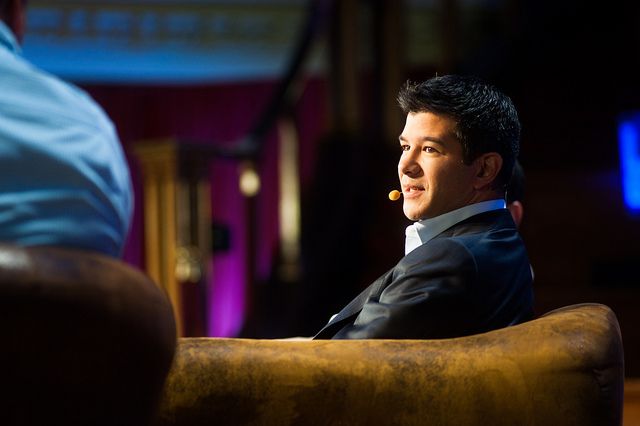Uber, the increasingly ubiquitous ‘push a button, get a ride’ company, is expanding its UberX service into iconic Silicon Valley. The first passenger — Uber pronounced him “Rider Zero” — was Aaron Levie, CEO of the Los Altos cloud-storage firm Box. Levine rode to a lunch meeting.
Now, if “Uber” and “UberX” elide in your mind, you’re not alone. And Uber’s marketing materials don’t help much. On the company’s website, UberX is defined as “the convenience of Uber at a lower price with mid-range cars in a variety of colors.” The key phrase in that description is “mid-range cars.” (Picture your brother’s forest green Honda Civic.) Über Uber, if you will, focuses on fancy cars and, in the words of Uber’s charismatic CEO Travis Kalanick, a hunger to travel the city in “baller” style.
But there’s a more critical distinction to UberX that the company routinely leaves unstated. Whereas Uber’s long-standing services connect riders to existing professional drivers, whether they’re driving taxi cabs or car service limousines, UberX’s drivers are average Joes and Janes recruited by the company. (In Levie’s case in Silicon Valley, his driver was identified simply as Mukhtar.) It’s ridesharing. And that makes UberX a sibling to Sidecar and Lyft, the latter of which has been in the news of late because one of its male drivers sent his female passenger creepy text messages.
Uber launched in San Francisco in the summer of 2010. UberX followed two years later, on last July 4th, with service in San Francisco and New York City. Last week, at the Fortune Brainstorm TECH conference in Aspen, Kalanick explained that it was the threat of competition with the Sidecar and Lyfts of the world that finally drove him into the ridesharing business:
[W]hat happened was they did it in California first and I’m like, holy cow, every trip that’s happening — I’m reading the law — every trip that’s happening is a criminal misdemeanor being committed by the person driving. I don’t think that’s a good law, but that is the law. So I’m just like, I’m kind of staying out of this one for a little bit.
And watched it happen for a year. But what they were able to do because no commercial insurance and because of their easy access to supply, the cost was really, really low. And so you could see a situation where they’d eat you up from the bottom up.
Kalanick spelled out his legal strategy in greater detail in an Uber Policy White Paper 1.0 he posted in April. His approach has two key prongs. One, “If a competitor is operating for 30 days without direct enforcement against transportation providers, then Uber will interpret that as ‘tacit approval’ of ridesharing activity.” And, two, “If clear and consistent enforcement has taken place within 30 days of a competitor rolling out a ridesharing service, then Uber will not roll out its platform for ridesharing in that jurisdiction.”
Or as Kalanick explained in Aspen, “if you have a policy of non-enforcement that goes 30 days — we call this regulatory ambiguity — then we’re coming in too because we want to participate in this kind of innovation.”
Though the push deeper into the more fraught world of the pure peer-to-peer economy certainly raises new legal questions for Kalanick, he is no stranger to the courtroom.
Uber has had plenty of legal trouble in the past. There was a well publicized battle over regulations in Washington, D.C. There are fights brewing from Denver to Paris.
But those debates have been over details in existing code like needing to wait an hour between requesting car and receiving one, or requiring that Uber prices go beyond a certain minimum. Those restrictions can be explained away as protectionist measures designed to benefit taxi companies and car services. UberX, though, is a whole new ballgame, and it exposes the company to a panoply of complaints that it is putting innovation ahead of safety. “These rogue taxis,” one L.A. cab company official has said, are bypassing all safety regulations created to protect riders and drivers. Now Uber has to make the argument that it has figured out the mechanics of ensuring safe rides.
UberX-style ridesharing has its selling points. For one thing, it costs less than Uber’s black car services, which opens the Uber experience to a wider range of riders. An Uber black car ride from San Francisco’s South of Market neighborhood to Fisherman’s Wharf is estimated at $20 to $23, while an Uber SUV starts at $35. But it has also opens up Uber to the idea that they’re far more than just grease on the existing machinery of the car-hire business. Uber has made its name by focusing on adding an on-demand layer to existing industries: Valentine’s Day flowers, Texas BBQ during SXSW, ice cream on a hot summer day.
“The demand was crazy,” a spokesperson recently told me of the recent delivery of frozen treats in 33 cities and 10 countries. “People love on-demand ice cream.”*
(Fewer, it seems, took Uber up on that chopper ride to the Hamptons. I asked the Uber spokesperson if anyone did. “Some,” he said after a pause, but he declined to say how many.)
Uber has made the calculation that it didn’t have the luxury of avoiding the ridesharing market, or that there’s no real reason to. Maybe a bit of both. But there’s a good chance that Kalanick’s bet on UberX complicates things the next time Uber Inc. is called upon to explain exactly what it’s doing to the transportation industry.

Nancy Scola is a Washington, DC-based journalist whose work tends to focus on the intersections of technology, politics, and public policy. Shortly after returning from Havana she started as a tech reporter at POLITICO.
















